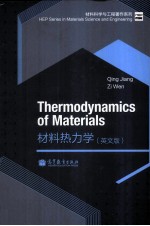
- 作 者:蒋青,文子著
- 出 版 社:北京:高等教育出版社
- 出版年份:2011
- ISBN:9787040296105
- 标注页数:298 页
- PDF页数:315 页
请阅读订购服务说明与试读!
订购服务说明
1、本站所有的书默认都是PDF格式,该格式图书只能阅读和打印,不能再次编辑。
2、除分上下册或者多册的情况下,一般PDF页数一定要大于标注页数才建议下单购买。【本资源315 ≥298页】
图书下载及付费说明
1、所有的电子图书为PDF格式,支持电脑、手机、平板等各类电子设备阅读;可以任意拷贝文件到不同的阅读设备里进行阅读。
2、电子图书在提交订单后一般半小时内处理完成,最晚48小时内处理完成。(非工作日购买会延迟)
3、所有的电子图书都是原书直接扫描方式制作而成。
Chapter 1 Fundamentals of Thermodynamics 1
1.1 Thermodynamics of Materials Science,Scope and Special Features of the Book 1
1.2 Concepts of Thermodynamics 5
1.3 Temperature and Zeroth Law of Thermodynamics 10
1.4 First Law of Thermodynamics 11
1.5 Entropy and Second Law of Thermodynamics 20
1.6 General Thermodynamic Relationships 24
1.7 Third Law of Thermodynamics 32
References 34
Chapter 2 Statistical Thermodynamics 37
2.1 Basic Concepts 38
2.2 Classical Statistic Thermodynamics of Independent Particles 43
2.3 Energy Mode and Energy Levels 47
2.4 Bose-Einstein and Fermi-Dirac Statistics 52
2.5 Application of Quantum Statistics 54
2.5.1 Spatial Configuration of Long Chain Polymers 54
2.5.2 Statistical Thermodynamics of a Paramagnetic Crystal 58
2.5.3 Negative Temperature 63
References 65
Chapter 3 Heat Capacity,Entropy,and Nanothermodynamics 67
3.1 Heat Capacity 67
3.1.1 Relations of Principal Heat Capacities 67
3.1.2 Magnetic Heat Capacity 69
3.1.3 Heat Capacity of Lattice Vibration of Solids 71
3.1.4 Electronic Heat Capacity of Metals 75
3.2 Entropy 78
3.2.1 Positional Part of Melting Entropy and Its Evaluation 83
3.2.2 Contribution of Vibrational Part of Melting Entropy of Semiconductors 85
3.2.3 Electronic Component of Melting Entropy 87
3.3 Nanothermodynamics 93
3.4 Melting Thermodynamics 95
3.4.1 A Melting Criterion 95
3.4.2 Existing Models for Size-dependent Melting of Crystals 96
3.4.3 Size-dependent Melting Thermodynamics of Crystals 100
3.5 Cohesive Energy 106
3.5.1 Size-dependent Cohesive Energy of Crystals 106
3.5.2 Vacancy Formation Energy and Cohesive Energy of Clusters 108
3.6 Size Effect on Bandgap of Ⅱ-Ⅵ Semiconductor Nanocrystals 114
References 116
Chapter 4 Phase Diagrams 119
4.1 Gibbs Phase Rule and Phase Diagram of Unary System 119
4.2 Clapeyron Equation in Condensed State Equilibria 121
4.3 Solution,Partial Molar Properties and Chemical Potential 126
4.4 Graphical Representation,Ideal and Regular Solutions 129
4.5 Equilibrium Conditions of Phases and Phase Diagram of Binary Systems 135
4.5.1 Complete Miscibility,Continuous Binary Solution Phase Diagram and Related Size Dependence 136
4.5.2 Immiscibility-Two Mechanisms of Phase Transitions 140
4.6 On Approximation of Gibbs Free Energy Change of Crystallization 144
4.7 Bandgap Energy of Binary Nanosemiconductor Alloys 148
References 154
Chapter 5 Thermodynamics of Phase Transitions 157
5.1 Thermodynamic Classification of Phase Transitions 157
5.2 Landau and Ising Models for the Second-order Phase Transitions 160
5.2.1 Landau Model 160
5.2.2 Ising Model and its Applications 162
5.2.3 Critical Exponent 164
5.3 Thermodynamics of Martensitic and Bainite Transitions 166
5.4 Glass Transition 174
5.4.1 Freezing into Solid State:Glass Formation versus Crystallization 174
5.4.2 Characteristic Properties of Glass Transition 178
5.4.3 Size Effect on Glass Transition 180
5.5 Ferromagnetic and Antiferromagnetic Phase Transitions of Nanocrystals 184
5.5.1 Size-dependent Ordering Temperatures of Ferromagnetic and Antiferromagnetic Nanocrystals 184
5.5.2 Thermal Stability in Exchange-biased FM/AFM Bilayers 191
5.5.3 Ferroelectric Phase Transition of Nanocrystals 197
5.5.4 Superconductive Phase Transition of Nanocrystals 202
References 205
Chapter 6 Thermodynamics of Interfaces 207
6.1 Point Defect Thermodynamics 208
6.2 Line Defects Thermodynamics 211
6.3 Thermodynamics of Interfaces 214
6.3.1 Thermodynamic Description of Surface Free Energy of Liquids and Solids 215
6.3.2 Thermodynamics of Surface Stress and Intrinsic Stress 216
6.3.3 Real Surface:Reconstruction and Relaxation 221
6.3.4 Equilibrium of Fluid Droplets and Solid Particles 225
6.3.5 Wulff Construction and Adsorption on Solid Surfaces 229
6.4 Solid-liquid Interface Energy 232
6.4.1 Bulk Solid-liquid Interface Energy and That at Melting Points 232
6.4.2 Size Dependence of Solid-liquid Interface Energy 239
6.4.3 Nucleus-liquid Interface Energy 242
6.5 Solid-solid Interface Energy 246
6.6 Solid-vapor Interface Energy or Surface Energy 248
6.6.1 Bulk Surface Energy of Elementary Solids 248
6.6.2 γsv0 of Several Ceramics with NaCl Structure 257
6.6.3 Size-dependent Surface Energy of Solids 261
6.7 Liquid-vapor Interface Energy or Surface Tension 264
6.7.1 Bulk Surface Tension and Its Temperature Coefficient 264
6.7.2 Determination of γLv0(Tm) and γ'Lv0(Tm) Values and γLv0(T) and γ'Lv0(T) Functions 267
6.7.3 Size Dependence of Liquid-vapor Interface Energy 275
6.8 Applications of Size-dependent Interface Energy 278
6.8.1 Thermodynamic Phase Stability of Nanocarbons 278
6.8.2 Static Hysteresis of Solid Transition of CdSe Nanocrystals 284
6.8.3 Critical Layer Number and Critical Misfit of Epitaxial Grown Metallic Thin Films 287
6.8.4 Reconstruction Possibility of fcc Metallic Surfaces at Room Temperature 291
References 293
Index 295
